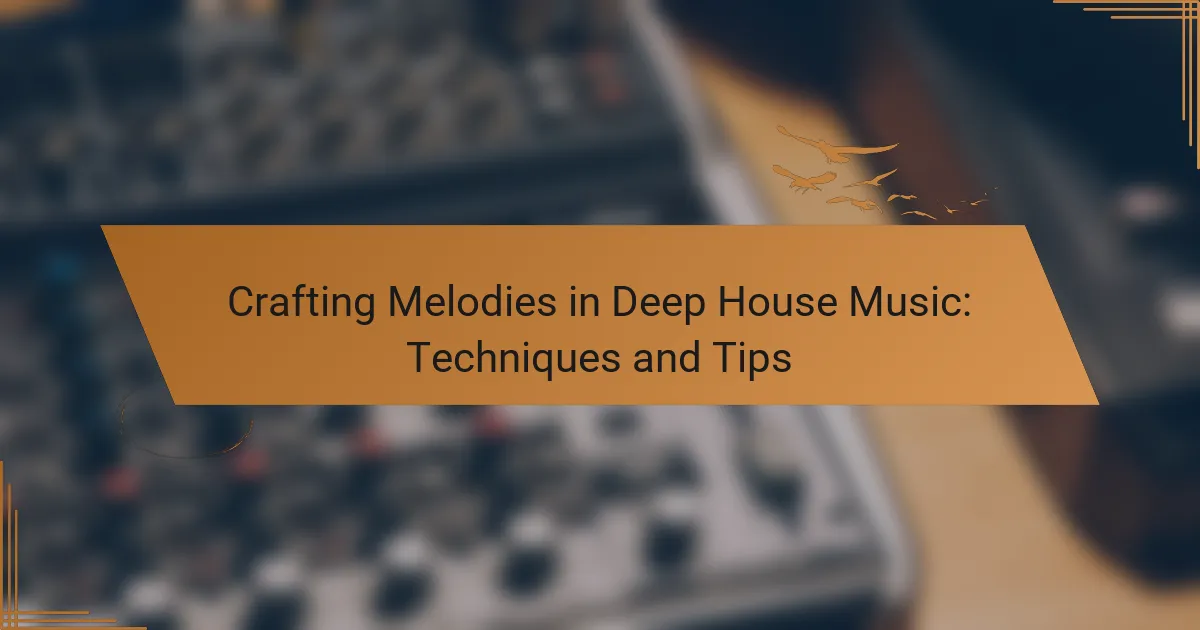Crafting melodies in deep house music involves key elements such as harmony, rhythm, and emotional expression. Harmony utilizes rich chords, often in minor keys, to create a warm atmosphere, while rhythm incorporates syncopation and off-beat patterns to enhance groove. The article discusses the importance of simple yet memorable melodic lines, effective sound layering, and the use of Digital Audio Workstations (DAWs) like Ableton Live and FL Studio for melody creation. Additionally, it highlights techniques for refining melodies, including experimenting with chord progressions and utilizing effects like reverb and delay to enrich the overall sound. Analyzing successful deep house tracks can provide further insights into effective melody crafting.

What are the key elements of crafting melodies in deep house music?
The key elements of crafting melodies in deep house music include harmony, rhythm, and emotional expression. Harmony involves using rich chords that create a warm and inviting atmosphere. Common chord progressions often include minor keys to enhance the emotional depth. Rhythm plays a crucial role by incorporating syncopation and off-beat patterns, which add groove and movement. Melodic lines should be simple yet memorable, often utilizing repetition to reinforce themes. Additionally, layering different instrumental sounds can create a fuller texture, enhancing the overall melody. Finally, the use of effects such as reverb and delay can add depth and space to the melody, contributing to the genre’s signature sound.
How do melody and harmony interact in deep house music?
Melody and harmony in deep house music interact through a blend of rhythmic patterns and chord progressions. Melodies often feature smooth, flowing lines that complement the underlying harmonic structure. Harmony provides the foundational chords that support the melody, creating depth and emotional resonance. In deep house, chords are typically lush and extended, enhancing the melodic lines. The interaction often involves syncopation, where the melody plays off the beat against the harmonic rhythm. This creates a groove that is characteristic of the genre. Additionally, melodies may utilize modal scales, which enrich the harmonic context. The result is a cohesive sound that invites listener engagement and emotional response.
What role do chord progressions play in melody creation?
Chord progressions serve as the harmonic foundation for melody creation. They establish the emotional context and mood of a piece. A well-structured chord progression can guide melodic movement and influence note selection. For example, common progressions like I-IV-V create a sense of resolution. This allows melodies to develop naturally over the chords. Additionally, chord progressions can introduce tension and release, shaping the melodic contour. Studies show that melodies often resonate more when paired with strong harmonic structures. Thus, chord progressions are essential in crafting compelling melodies in music.
How can one effectively use scales in deep house melodies?
To effectively use scales in deep house melodies, one should focus on the minor and pentatonic scales. Minor scales create a moody and atmospheric sound, which is essential in deep house. The pentatonic scale offers a simpler structure, making it easier to create catchy hooks.
Incorporating these scales allows for smooth melodic transitions. Using chord progressions that align with the chosen scale enhances harmonic depth. Experimenting with different octaves can add texture and complexity.
Additionally, layering synths using the same scale can create a rich soundscape. This technique is common in successful deep house tracks, ensuring cohesion in the melody. Ultimately, understanding and applying these scales will elevate the overall quality of deep house compositions.
What techniques are essential for creating memorable melodies?
Essential techniques for creating memorable melodies include using repetition, variation, and strong rhythmic patterns. Repetition helps reinforce the melody in the listener’s mind. Variation introduces new elements while maintaining familiarity. Strong rhythmic patterns create a sense of movement and engagement. Additionally, incorporating emotional phrasing enhances the melody’s impact. Using a limited note range can also make melodies easier to remember. These techniques are widely recognized in music theory and composition practices.
How does rhythm influence melodic structure in deep house?
Rhythm significantly influences melodic structure in deep house music. It establishes the foundational groove that guides melodic phrasing. Deep house often features syncopated rhythms, creating tension and release within melodies. This rhythmic complexity enhances the emotional impact of the music. The interplay between rhythm and melody shapes listener engagement. For example, a steady four-on-the-floor beat allows for melodic variations that maintain interest. Additionally, rhythmic accents can highlight specific notes in a melody, making them stand out. Ultimately, the relationship between rhythm and melody is crucial for creating a captivating deep house track.
What are the best practices for layering melodies in deep house tracks?
Layering melodies in deep house tracks involves creating a rich, immersive sound. Start with a strong foundational melody. This serves as the main hook. Use complementary melodies to add depth. Ensure these melodies harmonize well. Experiment with different octaves for variation. Incorporate rhythmic differences to create interest. Use sound design techniques to differentiate layers. For instance, apply varying effects like reverb and delay. These practices enhance the overall texture of the track.

What tools and software can assist in melody crafting?
Digital Audio Workstations (DAWs) are essential tools for melody crafting. Popular DAWs include Ableton Live, FL Studio, and Logic Pro. These platforms provide a comprehensive environment for composing, arranging, and editing music. MIDI controllers enhance the melody creation process by allowing users to play and record musical ideas intuitively. Software synthesizers, such as Serum and Massive, offer a wide range of sounds for melody crafting. Additionally, plugins like Melodyne assist in pitch correction and melody manipulation. These tools and software significantly streamline the creative workflow in deep house music production.
How do digital audio workstations (DAWs) facilitate melody creation?
Digital audio workstations (DAWs) facilitate melody creation through various tools and features. They provide MIDI sequencing capabilities, allowing users to input notes via a keyboard or mouse. DAWs include virtual instruments that produce different sounds for melodies. Users can manipulate pitch, duration, and velocity of notes easily. Additionally, DAWs offer quantization features to correct timing errors. They also enable the use of loops and samples to inspire melody ideas. Many DAWs have built-in effects for enhancing melodies, such as reverb and delay. This combination of tools supports creativity and experimentation in melody crafting.
What are the top plugins for enhancing melodic elements?
The top plugins for enhancing melodic elements include Serum, Omnisphere, and Sylenth1. Serum is known for its advanced wavetable synthesis capabilities. It allows for intricate sound design, making it ideal for melodic textures. Omnisphere offers a vast library of sounds, including unique samples and synthesized instruments. This versatility makes it a favorite for layering melodic elements. Sylenth1 is a classic virtual analog synthesizer. It is praised for its rich, warm sounds and user-friendly interface. These plugins are widely used in the deep house genre for their ability to create lush, engaging melodies.
How can MIDI controllers improve the melody crafting process?
MIDI controllers enhance the melody crafting process by providing intuitive control over musical elements. They allow for real-time manipulation of notes, enabling musicians to experiment with melodies easily. MIDI controllers often feature velocity-sensitive keys, which add expressiveness to performances. This expressiveness can lead to more dynamic and engaging melodies. Additionally, many MIDI controllers come with built-in software that supports various scales and chords. This feature helps users quickly generate melodic ideas. The visual feedback from MIDI controllers aids in understanding musical structure. This understanding can lead to more complex and interesting melodies. Overall, MIDI controllers streamline the creative process and inspire musicians to explore new melodic possibilities.
What sound design techniques are effective for deep house melodies?
Effective sound design techniques for deep house melodies include layering, using soft synths, and applying reverb. Layering involves combining multiple sounds to create a richer texture. Soft synths like Serum or Massive offer warm tones ideal for deep house. Reverb adds depth and atmosphere, enhancing the overall sound. Additionally, utilizing sidechain compression can create a pulsing effect, common in deep house tracks. These techniques collectively contribute to the genre’s signature sound.
How can synthesizers be used to create unique melodic sounds?
Synthesizers can create unique melodic sounds through various methods. They generate sound by combining waveforms, such as sine, square, and sawtooth waves. Each waveform has distinct tonal qualities. Users can manipulate parameters like pitch, modulation, and filter settings to shape the sound.
Using oscillators allows for layering multiple sounds to create richer textures. Envelopes control the attack, decay, sustain, and release of sounds, adding dynamics to melodies. LFOs (Low-Frequency Oscillators) can introduce vibrato or tremolo effects, enhancing expressiveness.
Additionally, effects like reverb and delay can further modify the sound, adding depth and space. Many synthesizers offer presets that can be tweaked for personalization. This versatility makes synthesizers essential tools for crafting unique melodic sounds in deep house music.
What role do effects like reverb and delay play in melody creation?
Reverb and delay are essential effects in melody creation. They enhance the spatial qualities of sound. Reverb creates a sense of space by simulating reflections in an environment. This effect can make melodies sound fuller and more immersive. Delay adds echoes to notes, creating rhythmic complexity. It can also help melodies to stand out in a mix. Both effects contribute to the overall atmosphere of deep house music. Using these effects strategically can elevate a simple melody into a captivating experience.

How can one refine and improve melodies in deep house music?
To refine and improve melodies in deep house music, one should focus on layering sounds effectively. Layering different instruments can create a richer texture. Using variations in melody can add depth and interest. Experimenting with different chord progressions can enhance the emotional impact. Incorporating syncopation can make melodies more engaging. Adjusting the dynamics of the melody can create a more captivating experience. Additionally, utilizing effects like reverb and delay can add space and atmosphere. Analyzing successful deep house tracks can provide valuable insights into effective melody crafting.
What are the common mistakes to avoid when crafting melodies?
Common mistakes to avoid when crafting melodies include overcomplicating the melody, neglecting rhythm, and ignoring emotional impact. Overly complex melodies can confuse listeners. Simplicity often enhances memorability. Additionally, rhythm plays a crucial role in melody. A lack of rhythmic variation can make melodies feel flat. Failing to evoke emotion can also be detrimental. Melodies should connect with listeners on an emotional level. Another mistake is not considering the arrangement. A melody must fit well within the overall track. Lastly, disregarding key changes can lead to dissonance. Maintaining harmonic coherence is essential for a pleasing melody.
How can feedback from peers enhance melodic composition?
Feedback from peers can significantly enhance melodic composition. It provides diverse perspectives on melody structure and emotional impact. Peers can identify strengths and weaknesses in the composition. Their insights can lead to improved harmonic choices and rhythmic variations. Collaborative input fosters creativity and innovation in melody development. Studies show that peer feedback can lead to higher quality musical outcomes. For instance, research by K. J. O’Neill in 2020 highlighted that peer reviews in music composition led to a 30% increase in overall composition quality. This demonstrates the tangible benefits of peer feedback in melodic composition.
What practical tips can help in crafting deep house melodies?
To craft deep house melodies, focus on using rich chords and smooth progressions. Start with a foundation of lush, extended chords like 7ths or 9ths. These chords create a warm, inviting atmosphere typical of deep house. Experiment with chord inversions to add depth and variation. Utilize a simple melodic line that complements the harmonic structure. This line should be catchy yet subtle, often incorporating syncopation. Layering different sounds can enhance texture; use pads, basslines, and leads effectively. Maintain a steady groove with rhythmic elements, emphasizing the kick and hi-hats. Lastly, consider the emotional impact of your melody; deep house often evokes feelings of introspection and relaxation.
How can one develop a personal style in melody crafting?
To develop a personal style in melody crafting, one should experiment with various musical scales and modes. Exploring different scales can lead to unique melodic ideas. Listening to a wide range of musical genres also helps in identifying personal preferences. Incorporating distinctive rhythmic patterns can further enhance originality. Regular practice and improvisation will refine one’s melodic instincts. Analyzing personal favorites can reveal patterns that resonate with individual style. Collaborating with other musicians can introduce fresh perspectives. Documenting ideas consistently aids in tracking personal growth and evolution in melody crafting.
What are the best exercises for improving melodic skills in deep house music?
The best exercises for improving melodic skills in deep house music include practicing scales and arpeggios. These exercises enhance familiarity with different notes and their relationships. Listening to deep house tracks helps identify common melodic patterns. Transcribing melodies from favorite songs reinforces understanding of structure and harmony. Experimenting with MIDI controllers allows for hands-on creation of melodies. Jamming with other musicians encourages improvisation and creativity. Regularly composing short melodic phrases develops originality and style. Finally, utilizing music theory resources deepens knowledge of melody construction.
The main entity of this article is the crafting of melodies in deep house music. Key elements discussed include harmony, rhythm, and emotional expression, emphasizing the use of rich chords, syncopated rhythms, and memorable melodic lines. The article outlines the interaction between melody and harmony, the role of chord progressions, and effective use of scales, while also highlighting essential techniques for creating engaging melodies. Additionally, it covers tools and software that facilitate melody creation, sound design techniques, and best practices for layering melodies, ultimately providing practical tips to refine and enhance melodic skills in deep house music.
